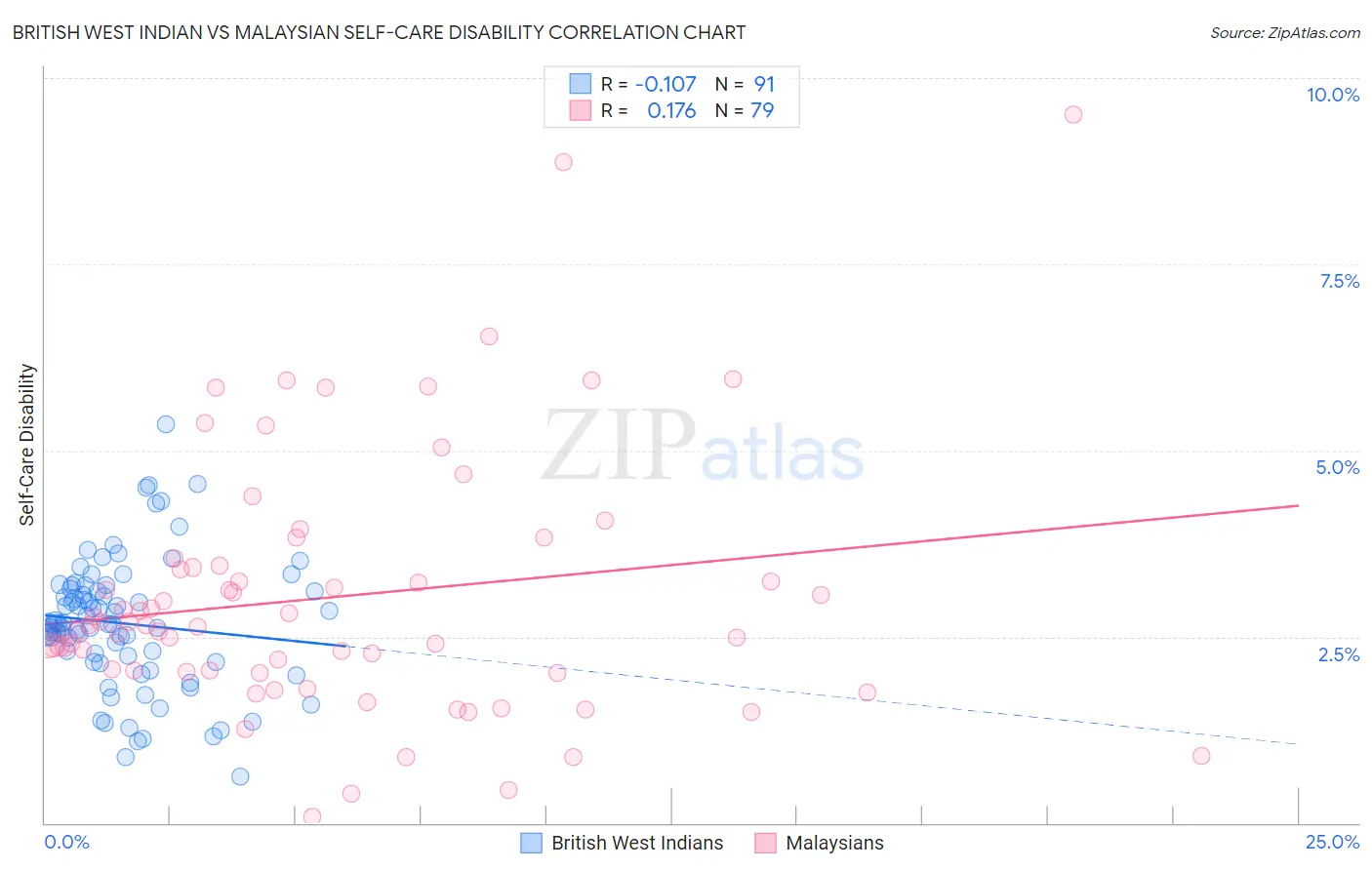British West Indian vs Malaysian Self-Care Disability
COMPARE
British West Indian
Malaysian
Self-Care Disability
Self-Care Disability Comparison
British West Indians
Malaysians
2.8%
SELF-CARE DISABILITY
0.0/ 100
METRIC RATING
310th/ 347
METRIC RANK
2.5%
SELF-CARE DISABILITY
7.7/ 100
METRIC RATING
209th/ 347
METRIC RANK
British West Indian vs Malaysian Self-Care Disability Correlation Chart
The statistical analysis conducted on geographies consisting of 152,617,328 people shows a poor negative correlation between the proportion of British West Indians and percentage of population with self-care disability in the United States with a correlation coefficient (R) of -0.107 and weighted average of 2.8%. Similarly, the statistical analysis conducted on geographies consisting of 225,907,967 people shows a poor positive correlation between the proportion of Malaysians and percentage of population with self-care disability in the United States with a correlation coefficient (R) of 0.176 and weighted average of 2.5%, a difference of 11.1%.

Self-Care Disability Correlation Summary
| Measurement | British West Indian | Malaysian |
| Minimum | 0.62% | 0.090% |
| Maximum | 5.4% | 9.5% |
| Range | 4.7% | 9.4% |
| Mean | 2.7% | 3.0% |
| Median | 2.7% | 2.7% |
| Interquartile 25% (IQ1) | 2.2% | 2.0% |
| Interquartile 75% (IQ3) | 3.1% | 3.5% |
| Interquartile Range (IQR) | 0.97% | 1.4% |
| Standard Deviation (Sample) | 0.87% | 1.7% |
| Standard Deviation (Population) | 0.86% | 1.7% |
Similar Demographics by Self-Care Disability
Demographics Similar to British West Indians by Self-Care Disability
In terms of self-care disability, the demographic groups most similar to British West Indians are Puget Sound Salish (2.8%, a difference of 0.070%), Bangladeshi (2.8%, a difference of 0.10%), Immigrants from Grenada (2.8%, a difference of 0.25%), Immigrants from Caribbean (2.8%, a difference of 0.26%), and Spanish American (2.8%, a difference of 0.30%).
| Demographics | Rating | Rank | Self-Care Disability |
| Immigrants | Belize | 0.0 /100 | #303 | Tragic 2.8% |
| Cree | 0.0 /100 | #304 | Tragic 2.8% |
| Immigrants | West Indies | 0.0 /100 | #305 | Tragic 2.8% |
| Aleuts | 0.0 /100 | #306 | Tragic 2.8% |
| Natives/Alaskans | 0.0 /100 | #307 | Tragic 2.8% |
| Immigrants | Grenada | 0.0 /100 | #308 | Tragic 2.8% |
| Bangladeshis | 0.0 /100 | #309 | Tragic 2.8% |
| British West Indians | 0.0 /100 | #310 | Tragic 2.8% |
| Puget Sound Salish | 0.0 /100 | #311 | Tragic 2.8% |
| Immigrants | Caribbean | 0.0 /100 | #312 | Tragic 2.8% |
| Spanish Americans | 0.0 /100 | #313 | Tragic 2.8% |
| Creek | 0.0 /100 | #314 | Tragic 2.8% |
| Immigrants | Cuba | 0.0 /100 | #315 | Tragic 2.8% |
| Menominee | 0.0 /100 | #316 | Tragic 2.8% |
| Immigrants | Dominica | 0.0 /100 | #317 | Tragic 2.8% |
Demographics Similar to Malaysians by Self-Care Disability
In terms of self-care disability, the demographic groups most similar to Malaysians are Central American (2.5%, a difference of 0.15%), Panamanian (2.5%, a difference of 0.23%), French (2.5%, a difference of 0.31%), Alaskan Athabascan (2.5%, a difference of 0.37%), and Immigrants from Russia (2.5%, a difference of 0.46%).
| Demographics | Rating | Rank | Self-Care Disability |
| Slovaks | 12.6 /100 | #202 | Poor 2.5% |
| Immigrants | Lebanon | 12.4 /100 | #203 | Poor 2.5% |
| Immigrants | Bahamas | 11.9 /100 | #204 | Poor 2.5% |
| Immigrants | Russia | 11.0 /100 | #205 | Poor 2.5% |
| Alaskan Athabascans | 10.4 /100 | #206 | Poor 2.5% |
| French | 9.9 /100 | #207 | Tragic 2.5% |
| Central Americans | 8.7 /100 | #208 | Tragic 2.5% |
| Malaysians | 7.7 /100 | #209 | Tragic 2.5% |
| Panamanians | 6.4 /100 | #210 | Tragic 2.5% |
| Native Hawaiians | 5.1 /100 | #211 | Tragic 2.6% |
| Samoans | 5.1 /100 | #212 | Tragic 2.6% |
| Ecuadorians | 4.7 /100 | #213 | Tragic 2.6% |
| Immigrants | Honduras | 4.7 /100 | #214 | Tragic 2.6% |
| Immigrants | Thailand | 4.5 /100 | #215 | Tragic 2.6% |
| Whites/Caucasians | 4.4 /100 | #216 | Tragic 2.6% |